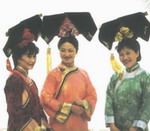|
|
 The Manchu ethnic minority
Like the Han people, the majority ethnic group in China, over 70 per cent of the Manchus are engaged in agriculture-related jobs. Their main crops include soybean, sorghum, corn, millet, tobacco and apple. They also raise tussah silkworms. For Manchus living in remote mountainous areas, gathering ginseng, mushroom and edible fungus makes an important sideline. Most of the Manchu people in cities, who are better educated, are engaged in traditional and modern industries.
Manchus have their own script and language, which belongs to the Manchu-Tungusic group of the Altaic language family. Beginning from the 1640s, large numbers of Manchus moved to south of the Shanhaiguan Pass (east end of the Great Wall), and gradually adopted Mandarin Chinese as their spoken language. Later, as more and more Han people moved to north of the pass, many local Manchus picked up Mandarin Chinese too.
An ethnic group originally living in forests and mountains in northeast China, the Manchus excelled in archery and horsemanship. Children were taught the art of swan-hunting with wooden bows and arrows at six or seven, and teenagers learned to ride on horseback in full hunting gear, racing through forests and mountains. Women, as well as men, were skilled equestrians.
The traditional costumes of male Manchus are a narrow-cuffed short jacket over a long gown with a belt at the waist to facilitate horse-riding and hunting. They let the back part of their hair grow long and wore it in a plait or queue. During the Qing Dynasty (1644-1911) the queue became the standard fashion throughout China, eventually becoming a political symbol of the dynasty. Women coiled their hair on top of their heads and wore earrings, long gowns and embroidered shoes. Linen was a favorite fabric for the rich; deerskin was popular with the common folk. Silks and satins for noble and the rich and cotton cloth for the ordinary people became standard for Manchurians after a period of life away from the mountains and forests. Following the Manchus' southward migration, the common people came to wear the same kind of dress as their Han counterparts, while the Manchu gown was adopted by Han women generally.
|
|